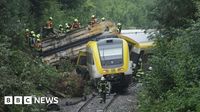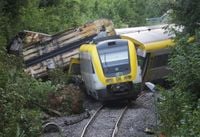On the evening of Sunday, July 27, 2025, a regional passenger train operated by Deutsche Bahn derailed near the town of Riedlingen in southwestern Germany, resulting in a tragic loss of life and numerous injuries. The accident occurred around 6:10 PM local time in a forested area approximately 158 kilometers west of Munich, along the railway line between Sigmaringen and Ulm.
The train, carrying about 100 passengers, experienced a derailment involving at least two carriages. The incident claimed the lives of three individuals: the 32-year-old train driver, a 36-year-old apprentice, and a 70-year-old passenger. In addition, 41 people were injured, with around 25 suffering serious injuries. Ten of the injured were airlifted to hospitals in nearby Ulm for urgent medical care.
Authorities quickly responded to the scene, deploying firefighters, paramedics, police, and rescue dogs to search for survivors and provide medical assistance. Rescue operations extended through the night, with helicopters transporting the critically injured. A collection point for relatives was established at a local community center, while Deutsche Bahn set up a special hotline to support affected families.
Preliminary investigations point to a landslide caused by heavy rainfall as the likely cause of the derailment. Local police reported that recent downpours led to an overflow of a sewage shaft, which in turn triggered a landslide on the embankment adjacent to the tracks. This natural event destabilized the railway embankment, causing the train to derail. Officials emphasized that there is currently no evidence of any external influence or mechanical failure contributing to the accident.
Thomas Strobl, the interior minister of Baden-Württemberg, remarked, "There have been heavy rains here, so it cannot be ruled out that the heavy rain and a related landslide accident may have been the cause. However, this is currently the subject of ongoing investigations." The crash site, located about 45 kilometers southwest of Ulm, remains closed as authorities continue their inquiries and clean-up efforts.
Photos from the scene showed carriages jackknifed and turned on their sides, with fallen trees and debris scattered nearby. Witnesses described the scene as harrowing. Karl Figler, a 76-year-old local resident, recounted, "It was terrible to witness. Two people were lying dead next to the train. They were carried away in blankets. At the same time, seriously injured people were being cared for." The heavy emergency service presence underscored the severity of the situation.
German Chancellor Friedrich Merz expressed his shock and condolences on social media platform X, stating, "I am in close contact with the Interior Minister and the Transport Minister and have asked them to support the rescue forces with all available means. We mourn the victims. I express my condolences to their relatives." Merz’s statement reflected the government's commitment to assisting the ongoing rescue and investigation efforts.
Deutsche Bahn CEO Richard Lutz also offered his sympathies, saying, "Such pictures shake us to the core," and pledged full support for the investigation into the cause of the derailment. He emphasized the company’s dedication to aiding victims and their families during this difficult time.
Rail traffic along the affected route between Sigmaringen and Ulm has been suspended indefinitely to facilitate rescue operations and investigations. Authorities have advised travelers to seek alternative routes and stay informed through official channels. The investigation aims not only to confirm the exact cause but also to evaluate existing safety measures and identify improvements to prevent similar tragedies in the future.
The derailment highlights the vulnerabilities of transportation infrastructure to extreme weather events, particularly in regions prone to heavy rainfall and landslides. As climate change contributes to more frequent and intense storms, such incidents raise urgent questions about the resilience of critical transit networks.
Local officials, emergency responders, and rail operators continue to work tirelessly at the site, ensuring that all survivors are accounted for and that the area is secured. The community mourns the loss of life and supports those affected by the crash, while investigators piece together the sequence of events that led to this devastating accident.





